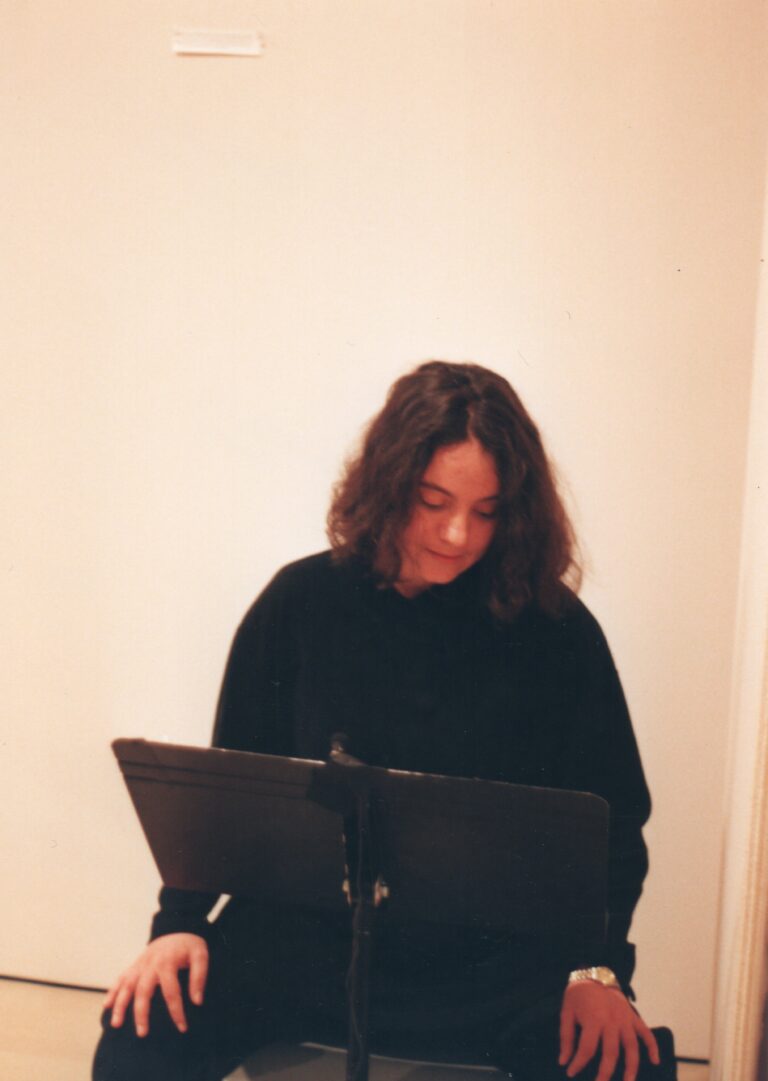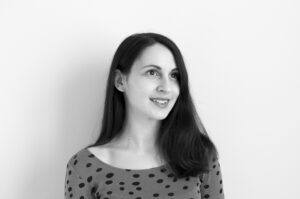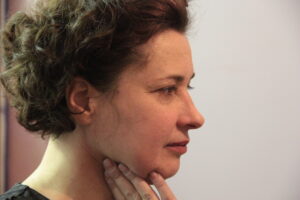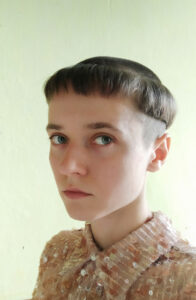Dubravka Đurić

– born in 1961 in Dubrovnik. She graduated and completed her master’s degree at the Department of Literature and Literary Theory at the Faculty of Philology in Belgrade, and she completed her PhD at the Department of English Language and Literature at the Faculty of Philosophy in Novi Sad. She has been active in the field of art since the beginning of the 1980s, primarily working on the borderline between poetry and visual arts. Her focus includes theoretical work and writing, mostly in the field of feminist visual art and female performance.
Poetry has always been the center of my interests. However, since my interest in poetry took shape in the context of visual arts, my experience and actions in that framework has given me an opportunity to establish a borderline practice between these two fields. This unstable form of poetry meant that my work was invisible and incompatible with the local (Yugoslav and Serbian) configurations of dominance and power in art and culture of that time, because the fields of poetry and visual arts have been separated since the early eighties.
From 1982 to 1986 I was a member of the informal theoretical-artistic Community for Spatial Investigation1. I began my work with performance and photography there. Thanks to the support of Biljana Tomić I had a solo exhibition in 1983 at the Gallery of the Student Cultural Center. At the opening I publically read poetry for the first time. The exhibition included black and white photographs depicting water surfaces, sun rays on water, ruins, fragments of fences, the relationship between shadows and leaves…2
At the Community for Spatial Investigation I began researching modern and postmodern dance3. The first performances belong to the genre of photo-performances. They were performed as private events, most often in natural environments where I established a direct relationship with the environment, such as a city park, garden or seaside, i.e. trees, water, stones, paths. The intention was to establish a meditative harmony with nature through the active presence of the body in a natural environment45.
From 1988 I began translating Language poetry6. In June 1991, just before the war in former Yugoslavia, the Language poets Charles Bernstein and James Sherry came to Belgrade and Novi Sad. While we were performing together, presenting their work, I noticed that they read their poetry in an unusual way, using their voice as a medium. As I read my translations of their poems, I began to mimic them. That initial moment inspired me to work and experiment with my own voice7. In 1991 and 1992 I had performances at the Student Cultural Center in Belgrade and Belgrade Cultural Center, and I performed poetry for the first time, combining dance movement and spoken words.
I spent several weeks in 1994 as a Poetic Fellow at SUNY – Buffalo, and then in New York and LA. I met Language poets as well as authors who were active in the field of performance and performance poetry. Among them were Jerome Rothenberg, David Antin and Cecilia Vicuña, and on that occasion I held performances as well8. During the 2000s I developed my own performances adding a narrative element and working with more awareness with space9.
My work with performance subsequently acquired meaning in the context of the global performative shift. An important segment of that shift was related to poetic performance. I still consider that my practice originated and continues to take place in the borderland between visual arts and poetry, whose common denominator is performance.
The text is written in collaboration with Simona Ognjanović (2022).
1This artistic formation based in Belgrade brought together a number of artists from Yugoslavia at the time. In Belgrade, the work was coordinated by Miško Šuvaković, Zoran Belić Weiss and me, with the participation of Nenad Petrović, Mirko Radojičić and Marko Pogačnik, among others. During its existence, a series of exhibitions and lecture cycles were organized in the Student Cultural Center, the Youth Center, Manak's House, etc. where artists such as Richard Longa, Hamish Fulton, Lawrence Weiner, Mary Bauermeister sent their works and published 4 issues of the Mental Space magazine. The community was erased from the common cultural memory. Still, I hope someone will research it sometime.2Image: Dubravka Đurić, Movement, performance, 1983, courtesy of the artist. This, I will say, esoteric approach, referred to the book Findhorn Garden (1976), while my photographs were visual templates that initiated the textual practice and were exhibited with accompanying texts. These photos also came from the experience of observing and studying a catalog of the British artists Hamish Fulton and particularly Richard Long, who would combine photos of nature or minimal intervention in the natural environment with text.
3I read numerous articles and observed photographs with performances of Isadora Duncan, Ruth St. Denis and Mary Wigman, as well as the authors gathered around Judson Theater. That experience was first incorporated into photo-performances, and later into dance-poetry practice.
4Image: Dubravka Đurić, Choreography of the Movement, performance, 1985, courtesy of the artist. An important reference were the photographs of Julia Margaret Cameron.
5Image: Dubravka Đurić, Dance in the Water, performance, 1985, courtesy of the artist.
6The first larger selection was published in the magazine Delo no. 8 from 1989.
7I always emphasize the following fact: in the culture that formed me and in which I worked there was a significant author who did performances and audio interpretations of her poetry - Katalin Ladik. However, I was introduced to the practice of sound poetry thanks to the American language poets Bernstein and Sherry, and not to phenomena from the local art scene such as Katalin Ladik or Vujica Rešin Tucić . My culture did not provide me with them as a model for the possible field of my own work.
8Image: Dubravka Đurić, Poetry of the Movement, performance, 1994, New York, courtesy of the artist. During 1994, I spent several weeks in New York and at SUNY Buffalo. In New York I performed with the poet Joan Retallack in a collaborative performance at the John Cage exhibition Rolyholyover, at the Guggenheim Museum. I worked on the video Sequen(I)ce with the poet Kristin Prevallet. See: youtube.com/watch?v=EdY3gMERBG0. From 1994/5 I became part of the Belgrade feminist scene thanks to the newly founded magazine ProFemina: magazine for women's literature and culture, as one of the four founders and editors. I started with a course on feminist visual art, primarily on women's performance at the Belgrade Center for Women's Studies, and founded the Ažin School of Poetry and Theory in 1996.
9See performance videos: Voices in Space, with Sanela Nikolić, Parobrod youtube.com/watch?v=jk67_TDp8lQ&t=9s Improvisations: Between Languages, Parobrod, youtube.com/watch?v=ucpotE6rhqU the Lecture performance in Belgrade at the at the Faculty of Architecture as part of ICA 2019 youtube.com/watch?v=SJ2fjrNLGu0&t=67s.
– rođena je 1961. godine u Dubrovniku. Diplomira je i magistrirala na Katedri za opštu književnost i teoriju književnosti na Filološkom fakultetu u Beogradu, a doktorirala na Katedri za engleski jezik i književnost na Filozofskom fakultetu u Novom Sadu. Aktivna je u polju umetnosti od početka osamdesetih godina, primarno delujući na rubnom području između poezije i vizuelnih umetnosti. Bavi se teorijskim radom i pisanjem pre svega u oblasti feminističke vizuelne umetnosti i ženskog performansa.
Poezija je uvek bila u središtu mog interesovanja. Ipak, budući da se moje zanimanje za poeziju oblikovalo u kontekstu vizuelnih umetnosti, iskustvo i delovanje u tim okvirima omogućilo mi je uspostavljanje rubne prakse smeštene između tih oblasti. Ta nestabilna pozicija značila je nevidljivost i neuklopljenost mog rada u tadašnje lokalne (jugoslovenske i srpske) konfiguracije dominacije i moći u umetnosti i kulturi, jer su od početka osamdesetih polja poezije i vizuelnih umetnosti bila odvojena.
Od 1982. do 1986. bila sam članica neformalne teorijsko-umetničke Zajednice za istraživanje prostora1. U okviru nje počela sam da se bavim performansom i fotografijom. Zahvaljujući podršci Biljane Tomić 1983. imala sam samostalnu izložbu u Galeriji Studentskog kulturnog centra na čijem sam otvaranju prvi put javno čitala poeziju. Na izložbi su bile izložene crno-bele fotografije na kojima su se mogli videti površina vode, zrak sunca uhvaćen na površini vode, ruševine, fragmenti ograda, odnos senki i lišća…2
U Zajednici za istraživanje prostora započinjem i istraživanje modernog i postmodernog plesa3. Prvi performansi žanrovski pripadaju foto-perfomansima. Izvođeni su kao privatni događaji najčešće u prirodnim ambijentima u kojima sam uspostavljala neposredan odnos spram okruženja poput gradskog parka, dvorišta ili morskog pejzaža, odnosno drveća, vode, kamenja, staza. Intencija je bila meditativno usaglašavanje sa prirodom kroz aktivno prisustvo tela u prirodnom ambijentu45.
Od 1988. počinjem prevoditi jezičke pesnike i pesnikinje6. U junu 1991, pred početak rata u bivšoj Jugoslaviji, u Beograd i Novi Sad dolaze jezički pesnici Čarls Bernstin i Džejms Šeri. Dok zajedno nastupamo predstavljajući njihov rad, primećujem da oni čitaju svoju poeziju na neobičan način, koristeći svoj glas kao medijum. Dok čitam moje prevode njihove poezije počinjem da ih imitiram. Taj inicijalni trenutak me je odveo radu i eksperimentu sa sopstvenim glasom7. Godine 1991. i 1992. nastupam u SKC i Kulturnom centru Beograda i izvodim prvi put poeziju kombinujući plesni pokret i izgovaranje reči.
Kao poetic fellow boravim nekoliko nedelja tokom 1994. na SUNY – Buffalo, zatim u Njujorku i Los Anđelesu. Upoznajem jezičke pesnikinje i pesnike, kao i autore i autorke koji deluju u domenu performansa i performans poezije. Među njima su i Džerom Rotenberg, Dejvid Antin i Sesilija Vikunja, a tom prilikom izvodim i performanse8. Dalje, tokom dvehiljaditih, razvijam svoje izvođenje dodajući narativni element i svesnije radeći sa prostorom9.
Moj izvođački rad naknadno zadobija smisao u kontekstu globalnog performativnog obrta. Važan segment tog obrta je vezan za pesnički performans. Još uvek smatram da je moja praksa nastala, i da se dalje odvija, u graničnom području između vizuelnih umetnosti i poezije, čiji je zajednički imenitelj izvođenje.
Tekst je napisan u saradnji sa Simonom Ognjanović (2022).
1Ova umetnička formacija sa sedištem u Beogradu okupila je niz umetnika i umetnica iz tadašnje Jugoslavije. U Beogradu rad su koordinirali Miško Šuvaković, Zoran Belić Vajs i ja, a u radu su, između ostalih, učestvovali Nenad Petrović, Mirko Radojičić i Marko Pogačnik. Tokom postojanja organizovan je niz izložbi i ciklusa predavanja u SKC, Domu omladine, Manakovoj kući, itd. na kojima su radove slali umetnici poput Ričarda Longa, Hamiša Fultona, Lorensa Vajnera, Meri Bauermajster. Izdali su 4 broja časopisa Mentalni prostor. Zajednica je izbrisana iz zajedničke kulturalne memorije. Ipak, nadam se da će je neko jednom istražiti.2Ilustracija: Dubravka Đurić, Pokret, performans, 1983, ljubaznošću umetnice. Taj, reći ću, ezoterični pristup, referirao je na knjigu Findhorn Garden (1976), pri čemu su moje fotografije bile vizuelni predlošci koji su inicirali tekstualnu praksu i bile su izlagane sa popratnim tekstovima. Ove fotografije nastale su i iz iskustva gledanja i proučavanja kataloga britanskih umetnika Hamiša Fultona i posebno Ričarda Longa, koji su fotografije prirode ili minimalnih intervencija u prirodnom ambijentu kombinovali sa tekstom.
3Čitala sam brojne tekstove i gledala fotografije sa izvedbama Isidore Dankan, Rut Sen Denis Meri Vigman, a zatim i autorke i autore okupljene oko Džadson teatra. To iskustvo bilo je najpre inkorporirano u foto-performanse, a kasnije i u plesno-poetsku praksu.
4Ilustracija: Dubravka Đurić, Koreografija pokreta, performans, 1985, ljubaznošću umetnice. Bitna referenca bile su fotografije Džuli Margaret Kameron.
5Ilustracija: Dubravka Đurić, Ples u vodi, performans, 1985, ljubaznošću umetnice.
6Prvi veći blok objavljen je u časopisu Delo no. 8. iz 1989. godine.
7Uvek naglašavam sledeću činjenicu: u kulturi u kojoj sam se formirala i u kojoj sam delovala postojala je jedna značajna autorka koja je radila performanse i zvučno je interpretirala svoju poeziju ─ Katalin Ladik. Međutim, sa praksom zvučne poezije sam se upoznala zahvaljujući američkim jezičkim pesnicima Bernstinu i Šeriju, a ne pojavama sa lokalne umetničke scene poput Katalin Ladik ili Vujice Rešina Tucića. Moja kultura mi ih nije pružila kao model za moguće polje mog sopstvenog rada.
8Ilustracija: Dubravka Đurić, Poezija pokreta, performans, Njujork, 1994, ljubaznošću umetnice. Tokom 1994. nekoliko nedelja boravim u Njujorku i na SUNY Buffalo. U Njujorku nastupam sa pesnikinjom Džoan Retalak u zajedničkom performansu u Muzeju Solomon Gugenhajm na izložbi Džona Kejdža Rolyholyover. Sa pesnikinjom Kristin Prelavet radim na videu Sequen(I)ce youtube.com/watch?v=EdY3gMERBG0 Od 1994/5. postajem deo beogradske feminističke scene zahvaljujući novoosnovanom časopisu ProFemina: časopis za žensku književnost i kulturu, kao jedna od četiri osnivačice i urednice. Počinjem sa kursom o feminističkoj vizuelnoj umetnosti, pre svega o ženskom performansu u beogradskom Centru za ženske studije, i osnivam Ažinovu školu poezije i teorije 1996. godine.
9Link: Videti snimke izvođenja: Glasovi u prostoru, sa Sanelom Nikolić, Parobrod, youtube.com/watch?v=jk67_TDp8lQ&t=9s Improvizacije: Između jezika, Parobrod, youtube.com/watch?v=ucpotE6rhqU, Lecture performance izveden u Beogradu na Arhitektonskom fakultetu u okviru ICA 2019. youtube.com/watch?v=SJ2fjrNLGu0&t=67s.
![]()


